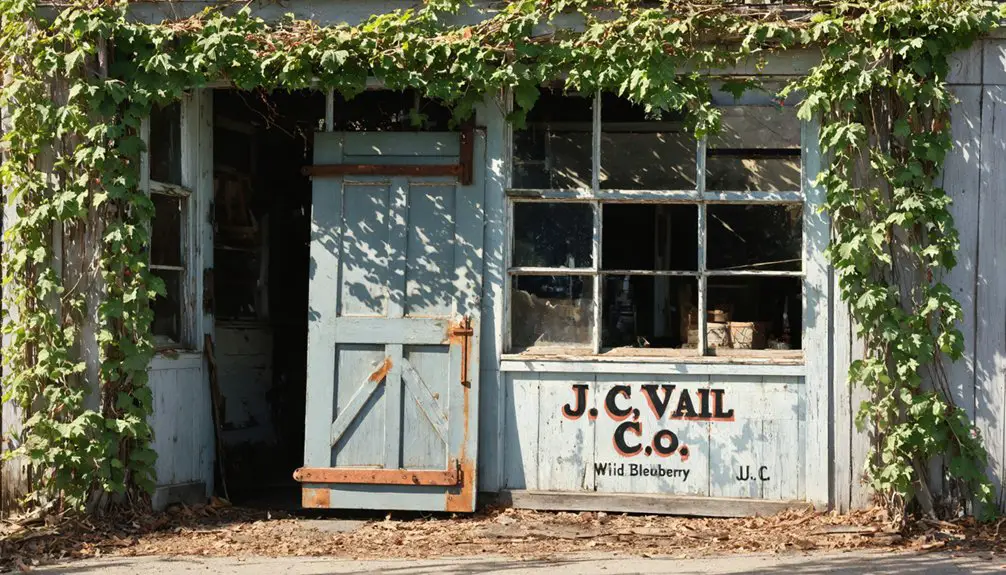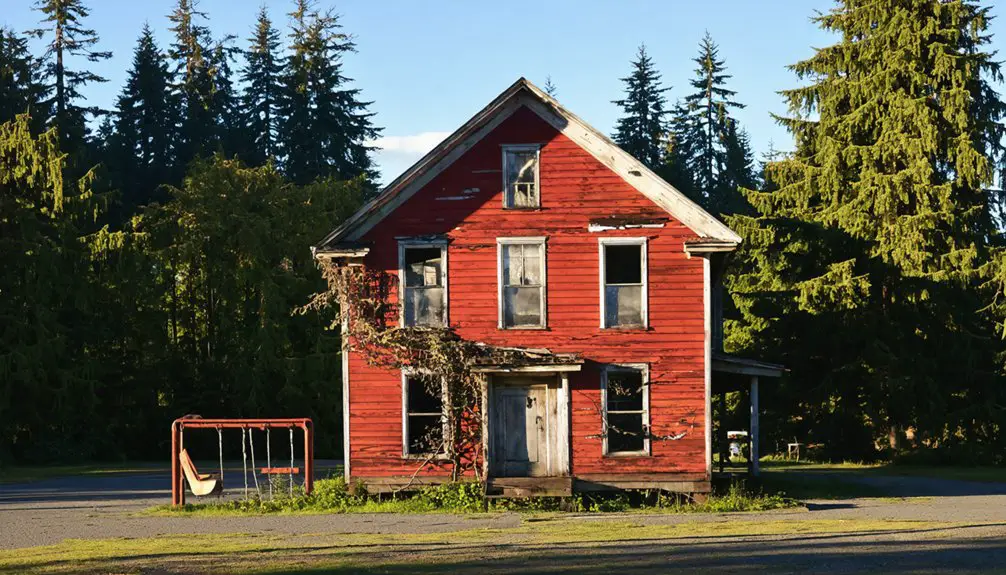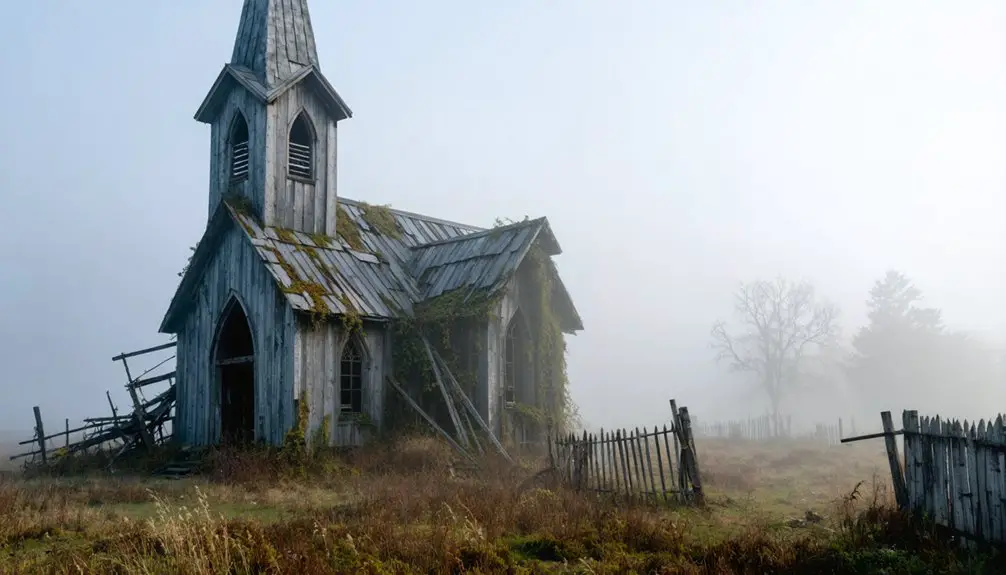You’ll find the ghost town of Vail tucked away near State Route 507 in Washington state, where Weyerhaeuser Timber Company built a thriving company town in the early 1900s. The town flourished during its peak years (1927-1960) with bustling logging operations, worker housing, and a close-knit community life. Today, about ten original structures remain standing, along with scattered foundations and industrial artifacts that tell the story of this once-vibrant timber town’s rise and decline.
Key Takeaways
- Vail was established by Weyerhaeuser Timber Company in the early 1900s as a logging town in Washington state.
- The town thrived from 1927 to 1960 with logging operations, sawmills, and a close-knit community supported by railroad access.
- Only ten original houses remain from 1969, with visible foundations and industrial artifacts scattered throughout the former townsite.
- Access requires navigating rural roads near State Route 507, with permission needed due to private property restrictions.
- The Vail Preservation Society, founded in 2006, works to protect the town’s heritage and document its history through community initiatives.
The Birth of a Timber Company Town
As the timber industry boomed across Washington state in the early 1900s, Weyerhaeuser Timber Company established Vail as one of its numerous company towns to support its expanding logging operations.
You’ll find that Vail emerged during a transformative period when steam-powered innovations like donkey engines and Shay locomotives revolutionized timber production, allowing logging to extend far beyond coastal areas. Under the leadership of George S. Long, the company focused on land acquisition rather than manufacturing.
In this carefully planned community, you’d have seen how Weyerhaeuser maintained tight control over labor relations through company-owned housing, stores, and facilities. The company’s strict oversight helped insulate against unions until the 1930s.
The town’s strategic location gave the company access to vast timber reserves while providing workers with essential services – though at the cost of their independence.
Every aspect of life in Vail centered around maximizing efficiency and maintaining a stable workforce for Weyerhaeuser’s ambitious logging operations.
Life During the Boom Years (1927-1960)
While Weyerhaeuser’s timber operations reached their zenith between 1927 and 1960, Vail transformed into a bustling hub of logging activity that you’d scarcely recognize from its humble beginnings.
The timber economy thrived, with logging camps and sawmills running at full capacity, providing steady work for hundreds of residents. You’d have found yourself part of a close-knit community where wages were modest but reliable, drawing workers from across the region. Much like the residents of Liberty’s mining camps, workers adapted to the rugged lifestyle of resource extraction. The railroad played a vital role, with rail line access enabling efficient timber transport and supporting the town’s growth.
Timber brought prosperity to Vail, transforming a quiet town into a thriving industrial center where workers found steady jobs and community bonds.
Life centered around community events like dances, church services, and seasonal celebrations. You could count on neighbors during harsh winters, and social organizations provided crucial support networks.
The town boasted essential services including a general store, post office, and basic healthcare, though you’d need to adapt to the seasonal rhythms of logging work and isolated rural living.
Structures and Architecture of Old Vail
You’ll find Vail’s original housing layouts followed the typical mining town pattern, with wooden homes clustered tightly along narrow streets near the central mining operations.
Similar to Liberty’s 1873 gold rush history, Vail developed as a bustling mining settlement with structures designed to support extensive mineral extraction activities.
The town’s mill building showcased the region’s standard construction techniques, featuring a wooden framework with stone foundations and specialized mechanical components for ore processing. Similar to numerous local saloons found in other mining communities, these buildings were essential gathering places during Vail’s heyday.
Like many Okanogan Country mining structures, the mill incorporated local timber and utilized practical design elements suited for the harsh climate and industrial demands of the era.
Original Housing Layouts
During Vail’s heyday in the early 20th century, the town’s residential structures followed typical mining settlement patterns with mainly wood-frame construction and simple rectangular designs.
You’d find housing designs clustered tightly together, often following mining claim lines, with most homes featuring one or two rooms that served multiple purposes.
Similar to pioneer buildings and equipment preserved in other ghost towns, these structures offer glimpses into early frontier life. Like the town of Liberty, which became known for its coarse placer gold, many mining settlements focused on extracting valuable minerals from the surrounding land.
The community layout emphasized practicality, with small-footprint cabins sporting front porches that doubled as workspaces and social areas.
These modest dwellings typically had plain wood clapboard or board-and-batten siding, small double-hung windows, and wooden plank doors.
Each home usually had nearby outbuildings like privies or storage sheds.
Roofing consisted of wood shakes or corrugated metal, while stone or brick chimneys provided essential heating through wood stoves.
Mill Building Design
As Vail’s timber industry flourished in the early 1900s, its mill buildings exemplified the shift from crude log structures to more sophisticated wood-frame construction that dominated Pacific Northwest industrial architecture.
You’ll find evidence of advanced timber engineering in the main sawmill’s heavy framing, which supported massive equipment and conveyor systems while maintaining open floor plans for efficient workflow.
The mill complex featured Craftsman-influenced designs with practical elements like broad loading docks, gabled roofs with generous eaves, and strategic window placement for ventilation. Similar to the Pacific States Lumber operation in Selleck, the facility employed sophisticated architectural features to maximize production efficiency. The search archive results helped document these architectural details through preserved records and photographs.
While architectural preservation has proven challenging due to fire risks and natural deterioration, you can still spot the careful balance of function and form in surviving features like masonry foundations and exposed beam work that once defined Vail’s industrial landscape.
The Slow Fade: Tracking Vail’s Decline
While many mining towns faced abrupt endings, Vail’s descent into abandonment followed a gradual path marked by interconnected economic and social challenges.
You’d have witnessed the town’s economic isolation deepen as new highways bypassed the community, while railroad activity – once the lifeline of Vail – steadily diminished.
The demographic shifts became increasingly apparent as younger residents sought opportunities elsewhere, leaving behind an aging population struggling to maintain the town’s liveliness.
Young blood drained from Vail’s veins as its aging heart beat slower, leaving only memories of its vibrant past.
The nearby Franklin mine disaster of 1894 cast a long shadow over the region’s mining communities, while declining coal prices and emerging energy alternatives further weakened Vail’s foundation.
As schools closed and businesses shuttered, the town’s once-bustling streets grew quieter until nature began reclaiming the landscape.
What Remains Today: A Ghost Town Tour

If you’re seeking remnants of Vail’s logging-era past, you’ll find only about ten original houses still standing from the 1969 survey, with most other structures having vanished into the surrounding forest.
You’ll need to navigate rural roads south of Rainier near State Route 507 to reach the ghost town site, though access may require permission due to private property restrictions.
The scattered foundations, equipment remnants, and occasional dilapidated buildings offer quiet testimony to this former timber company town‘s bustling heyday.
Visible Structures and Ruins
The remnants of Vail’s once-bustling mining community now dot the forested landscape in scattered ruins and weathered foundations. As you explore the site, you’ll find visible foundations of former homes and businesses emerging from the moss-covered ground.
Industrial artifacts, including old rail segments and mining equipment pieces, tell the story of the town’s extractive past. The stone walls of what was once the dynamite storage shed still stand roofless against the wilderness.
- Original building footprints revealed through stone foundation outlines
- Scattered mining equipment, including piping and furnace components
- Former railroad grade now serves as main access trail
- Moss-covered retaining walls marking old infrastructure
- Partial walls of industrial structures with concrete equipment bases
Accessing Historical Town Sites
Reaching Vail’s historic ghost town sites requires careful planning and respect for private property restrictions.
You’ll find the former logging town south of Rainier near State Route 507, though town accessibility is limited by private land ownership and a lack of maintained tourist facilities.
Unlike some Washington ghost towns with organized tours, you’ll need to arrange permissions before exploring Vail’s remaining sites.
The surrounding forest has reclaimed much of the area, and you’ll encounter a network of old logging roads rather than marked historical pathways.
While the location is reachable by private vehicle, there’s no public infrastructure or designated parking areas.
Historical restrictions and safety concerns mean you should contact local landowners and bring appropriate gear for backcountry exploration if you’re planning to visit.
Comparing Vail to Other Washington Ghost Towns
While many Washington ghost towns share similar stories of boom and bust, Vail stands apart from contemporaries like Franklin through its unique origins as a planned timber company town rather than a mining settlement. The timber industry’s influence shaped Vail’s development differently from resource-extraction towns focused on coal or precious metals.
You’ll find distinct patterns in how these towns evolved and declined across Washington’s landscape.
- Vail’s peak population of 600 exceeded Dearfield’s 300 but declined more gradually than Franklin’s sudden exodus.
- Unlike Franklin’s mining disaster, Vail’s decline stemmed from systematic resource depletion.
- The town’s planned layout differed from organic mining settlement patterns.
- Economic impacts were more predictable in Vail due to corporate oversight.
- While Franklin left industrial ruins, Vail’s remnants reflect its residential character.
Preserving Vail’s Historical Legacy

Since its founding in 2006, Vail Preservation Society (VPS) has spearheaded efforts to protect and celebrate this former timber town’s vanishing heritage.
You’ll find their work centered on the 1908 Old Vail Post Office, which serves as a cornerstone of their preservation mission. Through community engagement initiatives, VPS offers workshops, oral history projects, and interactive exhibits that bring the town’s past to life.
Despite facing preservation challenges from rapid population growth and development pressures, VPS continues to safeguard historic structures through adaptive reuse practices.
Their dedicated volunteers collect and document stories, photographs, and artifacts, ensuring Vail’s legacy endures. Through these efforts, you can still experience the authentic character of this historic place while VPS works to balance progress with heritage conservation.
Planning Your Visit to Vail’s Historic Site
Before starting on your journey to Vail’s historic site, you’ll need to plan carefully for the remote location and varying seasonal conditions.
The ghost town is accessible primarily through hiking trails and old railroad grades, with seasonal access restrictions affecting travel plans. You’ll want to check current conditions and trail status before departing, as weather can greatly impact your ability to reach the site.
- Pack essential supplies including water, food, and emergency gear
- Wear sturdy hiking boots suitable for muddy, uneven terrain
- Bring navigation tools as cell service is unreliable
- Check seasonal road closures, especially during winter months
- Carry a camera for capturing historic structures and landscapes
Remember to respect any posted boundaries and preserve the site’s historical integrity by leaving artifacts undisturbed during your exploration.
Frequently Asked Questions
Are There Any Reported Ghost Sightings or Paranormal Activities in Vail?
Barking up the wrong tree if you’re seeking ghost stories here. Research shows no documented paranormal investigations or supernatural sightings in this former timber town, unlike some other Washington ghost towns.
Which Notable Personalities or Celebrities Had Connections to Historic Vail?
You won’t find many celebrity visits or famous names – Vail’s notable historic figures were mainly Weyerhaeuser Company executives, local timber workers, and William Vail, the town’s original landowner.
What Happened to the Children Who Grew up in Vail?
Time marched on as you’d find most children scattered to the winds, taking childhood memories with them. They moved to nearby towns, seeking new opportunities while legacy stories faded into history.
Did Any Major Crimes or Mysterious Events Occur in Vail?
You won’t find documented historical crimes or unsolved mysteries specific to this location. While Western ghost towns often have dramatic tales, available records don’t show any major criminal incidents or mysterious events here.
What Natural Disasters or Accidents Significantly Impacted the Town’s History?
While records don’t mention significant earthquake damage or fire destruction, you’ll find the town’s decline was mainly driven by timber industry changes rather than any single devastating natural disaster.
References
- https://stateofwatourism.com/ghost-towns-of-washington-state/
- https://en.wikipedia.org/wiki/List_of_ghost_towns_in_Washington
- https://en.wikipedia.org/wiki/Vail
- https://washingtonourhome.com/washington-only-living-ghost-town/
- https://www.wta.org/go-outside/seasonal-hikes/fall-destinations/hidden-history-ghost-town-hikes
- https://www.historylink.org/File/23208
- https://www.historylink.org/File/23155
- https://revisitwa.org/waypoint/raymond/
- https://dp.la/item/e20bb2d62eb1cf551b375464a8ccf6d0
- https://foresthistory.org/research-explore/archives-library/fhs-archival-collections/inventory-weyerhaeuser-company-records-1864-2010/



